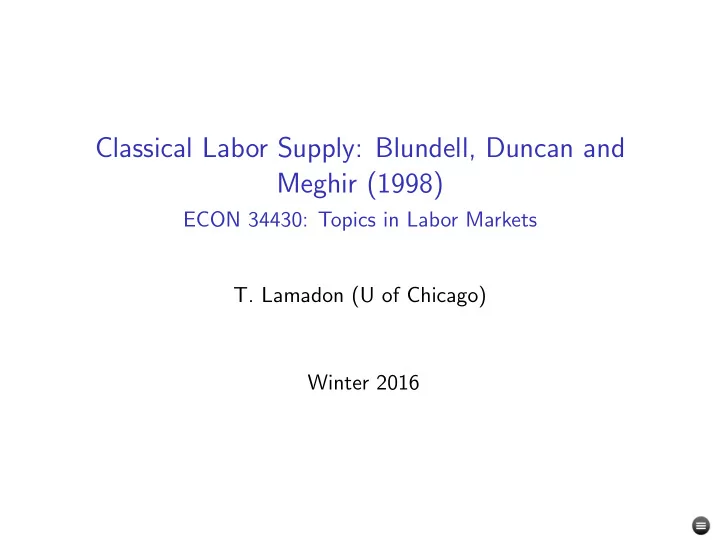

Classical Labor Supply: Blundell, Duncan and Meghir (1998) ECON 34430: Topics in Labor Markets T. Lamadon (U of Chicago) Winter 2016
Remember • We start with the following expression: h it = α + α w log( w it ) + α r R it + ǫ it and η H = α w − α R wh • if E [ ǫ it | w it , R it ] = 0 , then all good, just run OLS • but many reasons to believe that ǫ it is correlated with both w it and R it - hours and wages might depend positively on taste for work - selection into work
A group estimator • Blundell, Duncan, Meghir (1998) proposes a group estimator • Consider case without income effect, and assume g denotes the group of the individual, P it is participation h it = α + α w log( w it ) + ǫ it E [ u it | g , t , P it ] = a g + m t • the exogeneity restriction is at the group level (not E [ u it | w it ] = 0 ) • the additivity imposes common trends • the choice of groups is central
Diff and Diff interpretation • 2 groups, 2 time periods we get: ∆ t E [ h it | P it , g 1 , t ] = α w ∆ t E [log( w it ) | P it , g 1 , t ] + ∆ t m t (1) ∆ t E [ h it | P it , g 2 , t ] = α w ∆ t E [log( w it ) | P it , g 2 , t ] + ∆ t m t (2) • and so we have that: ∆ t E [ h it | P it , g 1 , t ] − ∆ t E [ h it | P it , g 2 , t ] α w = ∆ t E [log( w it ) | P it , g 1 , t ] − ∆ t E [log( w it ) | P it , g 2 , t ] • as long as the denominator is � = 0 we can recover α w . • it requires for the post-tax wage growth to be different in different groups
What did we gain? • We exchange E [ u it | P it , w it ]=0 with E [ u it | P it , g , t ] = a g + m t • this allows for taste heterogeneity as long as the difference across group remains fixed over time. • it also allows for common time shocks • In diff-in-diff you can test the common trend assumption using pre-trends (not clear they did it here)
Extensions from the simple model 1 control for participation 2 introduce non labor income 3 control for effect of discontinuity in tax schedule
Ext 1 : Control for participation • They use a selection correction • Following Heckman (74,79), if you have a participation decision and joint normality you can 1 estimate participation decision using probit P it ∼ γ Z i t 2 then add the inverse Mills ratio λ it as regressors to main equation 3 here this is done at the group level • They assume E [ u it | P it , g , t ] = a g + m t + δλ gt • where λ gt is derived using a participation equation
Ext 2 : Non earned income • Recall original equation with income effect, we need to control for non-earned income • Supplement regressors with µ it = c it − w it h it • dealing with saving decisions?
Ext 3 : Discontinuity in tax schedule • this is another selection problem • estimate another selection equation with another Mills ratio • or, exclude individuals around the kink
Data • UK Family expenditure survey (1978-1992) • married or cohabiting women with employed partners • 16781 women • repeated cross-section, no panel, so group approach is important • groups are cohort decade interacted with education • differential variation in wage growth is due to - differential tax changes across groups - differential wage gains across groups
Results 1 • it appears that selection into participation is not very important • however selection at the kink might be, and selection on wages as well
Results 2 • all income effect are negative, consistent with theory • strongest effect is for mother with 3-4 children
References
Recommend
More recommend